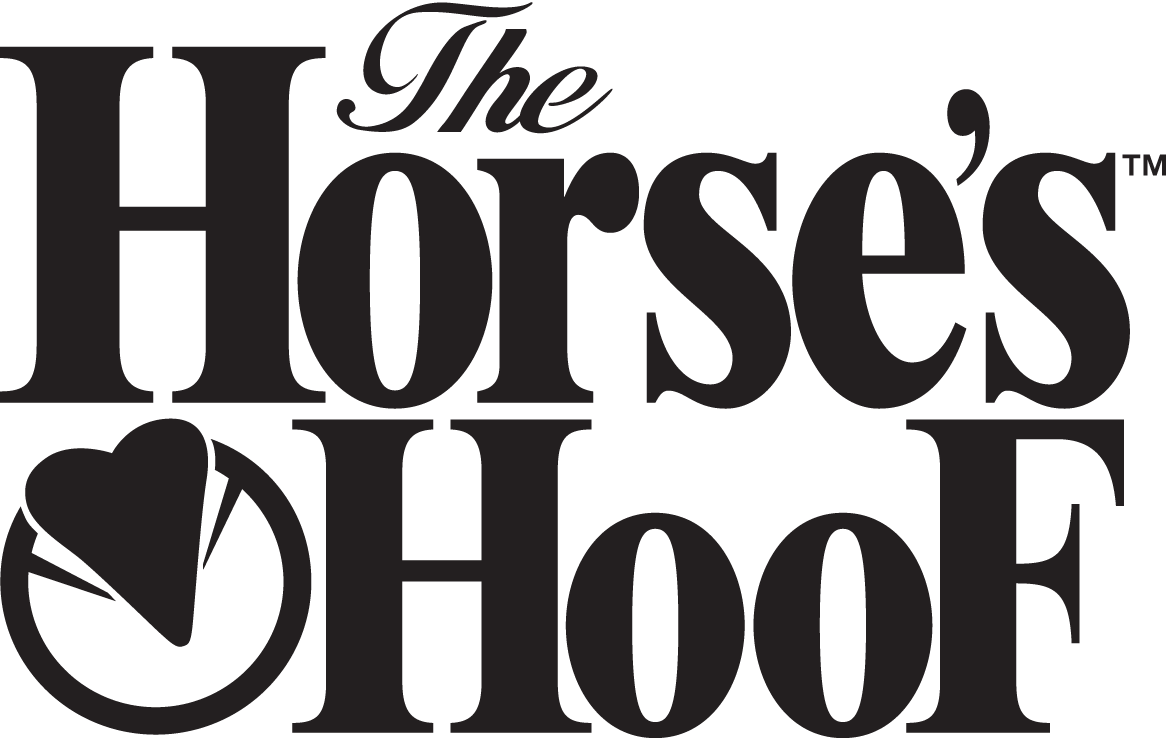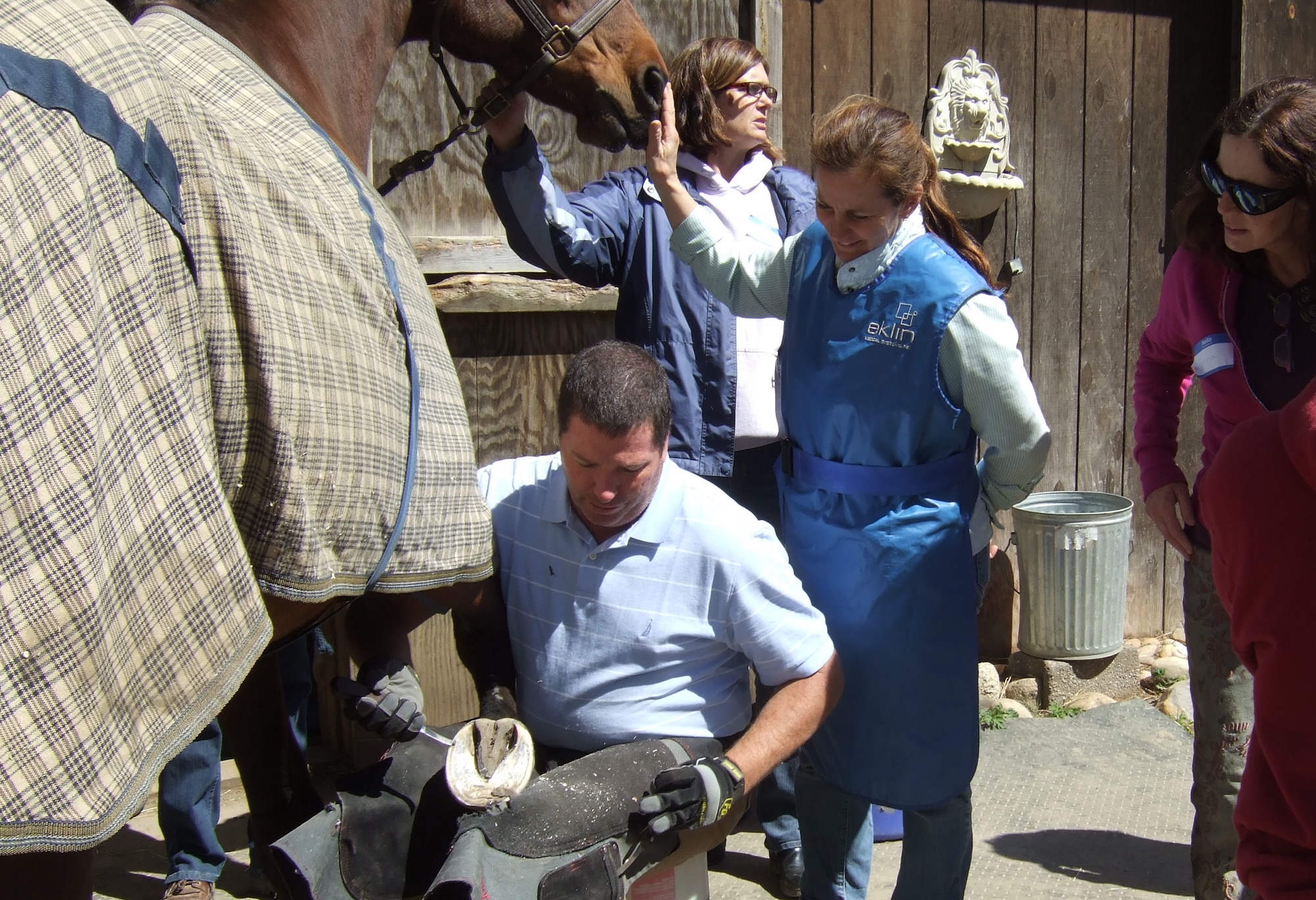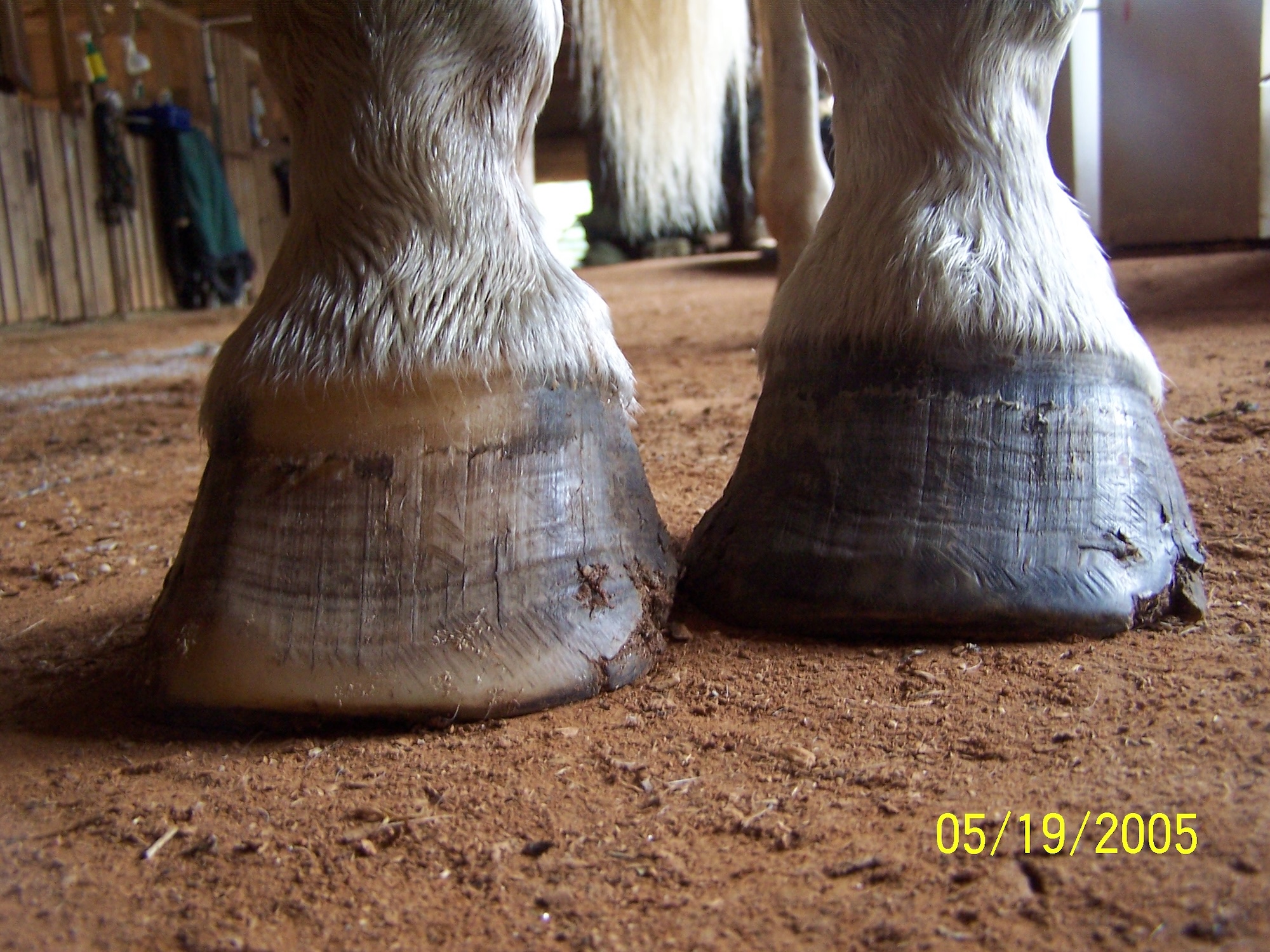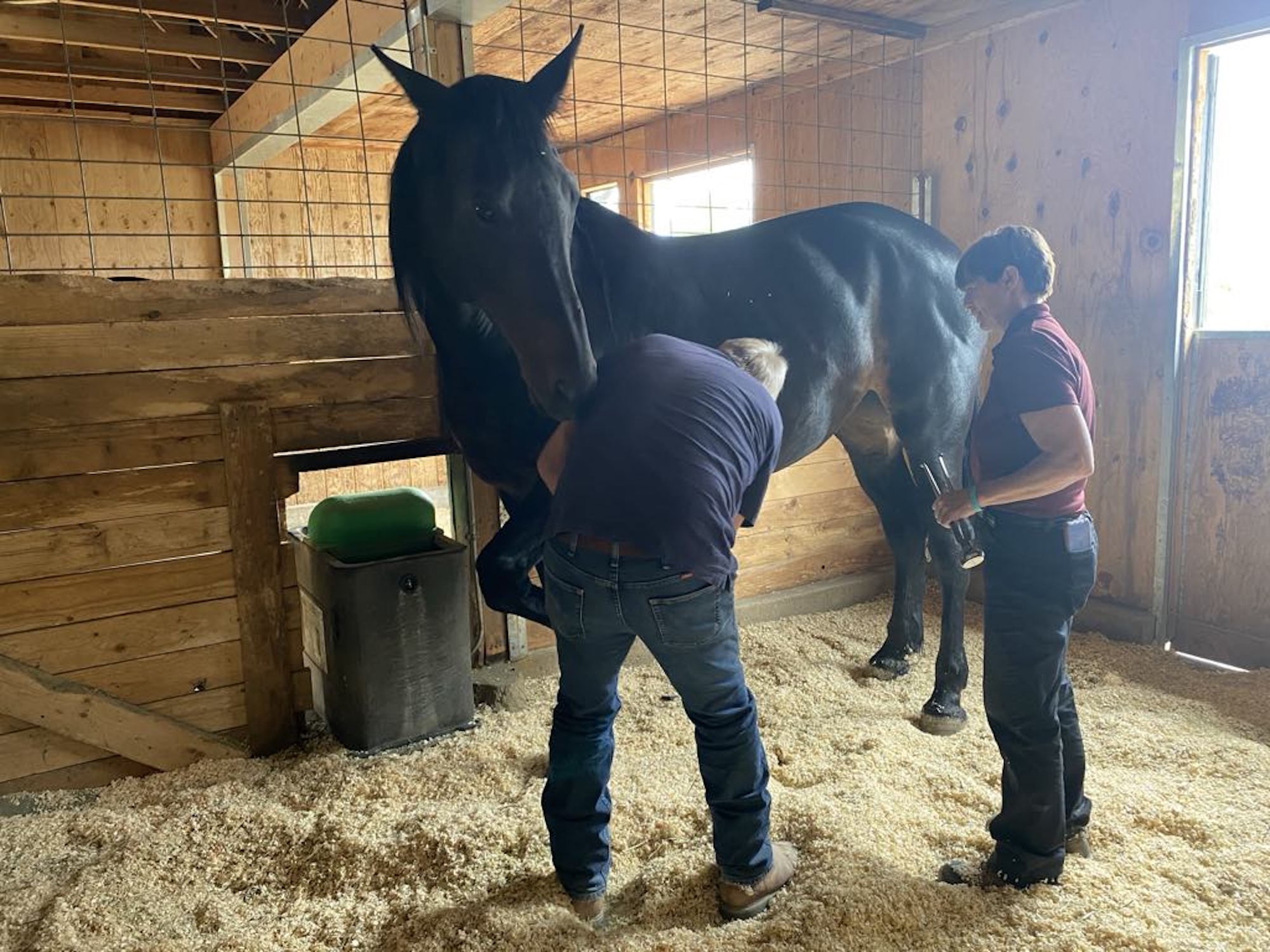There is a clash going on behind the scenes that many horseowners are not even aware of, and that is the paradigm difference between the “allopathic” model of mainstream equine care, and the “naturopathic” model of natural, holistic equine care. It is important to understand both, and clearly know the differences.
Let me start out by saying that there can be allopathic practitioners who actually practice in a more holistic, naturopathic way, especially if they have sought further education and think “outside the box.” And there can be naturopathic practitioners who, whether they are aware of it or not, are really practicing mainly allopathically. But what do these terms actually mean?

Is it possible for vets and holistic barefoot professionals to actually communicate with each other? Not without EACH ONE leaving their comfort zone.
Allopathic medicine is the method practiced by the majority of doctors and hospitals, both human and animal. Simply put, pharmacologically agents or physical interventions (such as surgeries) are the main tools used to treat or suppress symptoms of disease. In this model, a disease is first “diagnosed,” then drugs or other treatments are prescribed, based not so much on that individual person, but rather on what has worked in the past for the majority of people/animals (“standard medical procedures”). Keep in mind that “worked” does not mean “cured.” Often diseases are considered “incurable” (such as diabetes), and there is usually little focus on finding the root cause of the symptoms.
Naturopathic medicine operates from a completely different premise, instead emphasizing prevention, treatment and optimal health by using therapies that encourage the patient’s own self-healing mechanism. The core belief of naturopathic medicine is that ALL living beings have an innate intelligence operating within them, and this intelligence, often called the healing power of nature, is capable of miraculous feats of healing, if only provided with the necessary conditions. Naturopathic practitioners try to identify and remove whatever obstacles might be blocking this healing from taking place. Therefore, the focus is not so much on relieving the symptoms, but rather on finding the root cause of the dysfunction, removing that, and supporting the entire body while the subsequent healing takes place. There is little need for a definitive “diagnosis,” because restoring health is what restores health! The whole person – or whole animal – is treated, including their physical, mental and emotional needs, as well as considering environmental and social factors.
One example of the drastic difference between allopathic and naturopathic medicine would be the treatment of Type 2 diabetes. It is a scientifically established fact that Type 2 diabetes is caused by poor diet and lifestyle choices. Allopathic medicine will advise improving a patient’s diet, but that is not the focus; the diabetes will be treated with drugs. In most cases, the patient will never change their diet and lifestyle enough to get off the medication. In naturopathic medicine, the diabetes will simply be seen as a sign that the body has broken down, due to poor diet and lifestyle, and the cure is to completely and permanently change that diet and lifestyle. Once the person restores their health, the diabetes will simply go away on its own.
How does this relate to barefoot trimming? Simply put, the barefoot orthopedic rehabilitation of horses’ hooves to a healthy condition IS the naturopathic model of hoofcare. The origins of modern barefoot came to us directly from a holistic veterinarian in Germany (Dr. Hiltrud Strasser), practicing barefoot hoofcare in her clinic since the 1980’s. From the beginning, the barefoot method was a complete holistic method of horse care: not only are the shoes removed, but the horse’s lifestyle is changed, including recommendations to keep horses out of stalls, in a herd lifestyle, with freedom of movement 24/7, continual access to forage, improved natural diet, and frequent trims to keep the hooves in a physiologically correct form. The application of the wild horse model to domestic horses is holistic hoofcare.
However, you certainly can pull a horse’s shoes, trim its hooves, and still use only the allopathic model. It is all in the underlying philosophy, or paradigm. If the hooves are trimmed in such as way as to provide symptom relief only, that is the allopathic model. If the trims are done without the holistic approach, without concern for the horse’s lifestyle, environment, nutrition, etc., then trimming loses its naturopathic base, and crosses over to allopathic. And yes, if boots, glue on shoes, or nailed on plastic shoes are used to provide symptom relief only, that steps right into allopathic. The question always remains, is that truly what is best for the horse in the overall picture? Will this suppress or encourage the necessary healing to take place? In many cases, no one ever wanted healing anyway. Just pain suppression. And that is allopathic.
Allopathic trimming is pure farriery. In general, farriers use the allopathic model. It’s NOT the shoe – it is the paradigm. Even if a farrier does not shoe at all, their education, understanding, and philosophy are still allopathic. If the horse is lame, you eliminate the lameness, by whatever means possible, and that is priority number one. That’s why farriers and conventional veterinarians can easily communicate – same philosophy. If the horse has a problem, there is a diagnosis, then a treatment prescribed, which aims to suppress the symptom. There are many tricks that can be used to suppress the symptoms of hoof pain caused by poor hoof form. In the end, allopathic farriery usually does not create actual healing, but by that point, everyone forgets about it, and the horse was just “incurable.”
All application of horseshoes (of any kind) to suppress pain in the hooves is allopathic medicine, especially when it is done so the horse can continue to be “used.” The use of drugs or surgical techniques to fix a hoof problem is allopathic medicine. This does not mean that allopathic medicine is “bad” – it is simply one paradigm, or belief system, about the best way to deal with a physical problem. Sometimes allopathic medicine can save lives. Other times, it can damage or destroy, with side-effects from the treatment that are far worse than the original problem.
Sadly, this paradigm difference explains why it is next to impossible for a naturopathic, holistic hoofcare practitioner to be able to adequately communicate with a typical veterinarian about a client’s hoof problems. The veterinarian will be baffled, and unable to understand, because everything is different: cause and effect, the ideal shape of a functional hoof, and the goals for treatment. Most veterinarians do not even understand the principles of naturopathic medicine, therefore the hoofcare practitioner will be ineffective in explaining what they do and why. In most cases, the unsuspecting owner will be caught in the middle, and forced to choose one or the other. A less-educated owner will choose the bigger authority, which is the vet, and in the end, the horse will pay for that choice with allopathic treatment. It’s a sad, frustrating, heartbreaking situation that we see repeated over and over again, both in our own practice, and with other holistic practitioners around the world.
This stark contrast in philosophical difference provides a clearer understanding as to WHY the barefoot method came under such violent attack by the general horse world after it was first introduced in the late 1990’s. The holistic, naturopathic focus is truly what distinguished the new barefoot method, and separated it from pasture trims, unshod hooves, horses who “didn’t need shoes,” and anything else previously practiced. However, it only took a few short years before many “barefooters” were aligning themselves to be against rehabilitative trimming, instead with an emphasis on pain relief that certainly appealed to the allopathic world. But it doesn’t work long term, because the heart of holistic trimming IS naturopathic, and healing MUST take place before hooves can be healthy and pain-free. Sadly, the new general “acceptance” of barefoot horses and barefoot trimming is only under the assumption that such trimming is done allopathically. There is still little support for rehabilitative trimming to create long-term healthy hooves.
Yes, there can be a gray area, but it’s a slippery slope. One can tread lightly between both worlds, trying to obtain pain relief through the hoof care application, while attempting to progress through the healing, but that is usually difficult and can be fraught with failure. If you try to do both, you usually end up not doing either very well. The temptation will be strong to gravitate towards a focus on pain relief. This is why gimmicks, gadgets, and devices are dangerous – they pull the user closer to treating symptoms instead of confronting the cause.
The cause is usually SIMPLE, but people do not want to hear it. Most horses have damaged feet, due to incorrect hoofcare from birth and incorrect living conditions. Most shod horses have some level of laminitis and/or founder, even just a small degree. Most barefoot horses have neglected hooves, due to lack of mileage and/or inadequate trimming, and can have as much damage as shod hooves. But most owners do not want to hear all that, either due to guilt or disbelief. They can find hundreds of other people to tell them their horse’s hooves are NOT unhealthy at all, and don’t need any rehabbing. Or the lame ones will be just fine, with a shoe nailed on, or some other magical device.
In fact, that is the lure of the allopathic model of hoof care. To the unsuspecting owner, or frankly MOST horse owners, it is an easy sell. The farriers and the vets can line up with promises of instant pain relief, and when one doesn’t work, there will be dozens of allopathic practitioners ready to try some new pain relieving device, gadget, or method.
In contrast, the naturopathic model of hoof care is a disaster for “selling.” What owner wants to contemplate that their beloved horse has genuinely pathological hooves created by their own inept care, even if they were ignorant about it? Too many horses are still kept in stalls, isolated, fed meals, receive far too little exercise, and are treated like sports equipment. No one wants to change everything. Just like the diabetes patient, who can easily take a drug to control their diabetes, instead of reworking their entire lifestyle and diet. Unless an owner has a dire, life-threatening problem with their horse’s feet, or they have gone out of their way to become especially well-educated about hooves and the nature of healing, there is little appeal for holistic hoofcare. Sadly, the general horseowning public lives in an allopathic world and has no desire to do what it takes to have truly healthy hooves and healthy horses.
Now you can see why frustrated barefoot trimmers can easily leave their high moral ground and cave in to a more allopathic style. This will create more customers for them, greater success in the allopathic world, and good working relationships with their local veterinarians, as they can finally communicate. Once a trimmer abandons a holistic approach, and begins trimming and/or shoeing with the focus of being more of a “farrier,” and to create symptom relief, their lives will become much easier. Instant gratification; owners will be happier, horses will be “sounder” – it’s a win-win!
But is that the right thing for the horse? And will that lead to a lifetime of soundness?
The holistic solutions for healing unhealthy hooves are just as simple as the cause. Horses really do need to live outdoors, in a group herd environment, on as much acreage as possible, with free access to forage. Their hooves need to be trimmed as often as necessary, about once a month for most domestic horses, and the hoof form needs to be naturally shaped and physiologically correct. Once hoof form is restored to a natural shape that allows the hooves to function properly, the hooves will begin to undergo a healing rehabilitation process that can take months, or even years, depending on where the hooves began. Of course, corrective trimming must be done in conjunction with lifestyle improvements, including special attention to exercise, terrain, and nutrition. The horse owner must take full responsibility for the outcome. It is simple – but not easy.
There is certainly a place for allopathic medicine, and in a crisis, there is a often a need for allopathic pain relief, through drugs or hoofwear application. Of course, there might be other times to compromise. What I am hoping is that we all consider the full ramifications of our choices, and understand how it impacts the horse in the long term. Horse care today is a market driven largely by the horseowner (for good or for bad), and their own knowledge, or lack of it, plays the determining role. Every horse owner and professional needs to understand in full detail the difference between allopathic and naturopathic models of medicine and hoof care, and know exactly which model they are applying – and why. If you’re a hoof care professional, it is your responsibility to educate your clients, and potential clients, about what you do.
by James and Yvonne Welz, published in The Horse’s Hoof Magazine, Issue 64, Fall 2016
See the full content listing of all issues of The Horse’s Hoof Magazine! We also provide instructions on how to read the issues for free on Hoof Help Online.
For a detailed listing of all articles on The Horse’s Hoof website, please visit our Article Directory.




